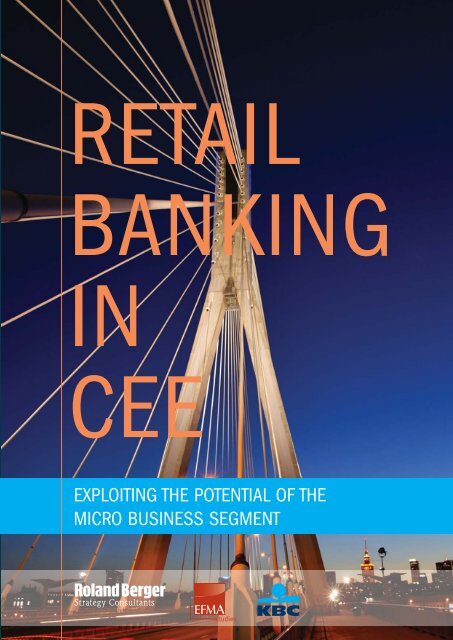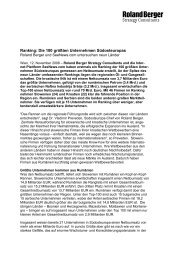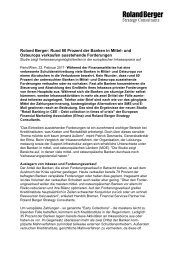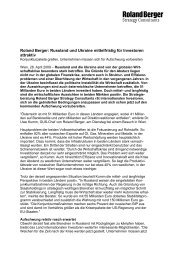Retail Banking in CEE: Exploiting the Potential of ... - Roland Berger
Retail Banking in CEE: Exploiting the Potential of ... - Roland Berger
Retail Banking in CEE: Exploiting the Potential of ... - Roland Berger
Create successful ePaper yourself
Turn your PDF publications into a flip-book with our unique Google optimized e-Paper software.
RETAIL<br />
BANKING<br />
IN<br />
<strong>CEE</strong><br />
EXPLOITING<br />
OPPORTUNITIES<br />
THE<br />
AND<br />
POTENTIAL<br />
HURDLES<br />
OF THE<br />
MICRO BUSINESS SEGMENT
CONTENTS<br />
1<br />
CONTENTS<br />
3<br />
5<br />
6<br />
9<br />
PREFACE<br />
FOREWORD<br />
SUMMARY OF KEY FINDINGS<br />
PART I – IMPORTANCE OF MICRO BUSINESS – HIGH POTENTIAL WITH SEVERAL QUESTION MARKS<br />
Macroeconomic overview <strong>of</strong> micro bus<strong>in</strong>esses <strong>in</strong> <strong>the</strong> EU<br />
Attractiveness and growth potential <strong>of</strong> <strong>the</strong> micro segment for <strong>CEE</strong> banks<br />
<strong>Bank<strong>in</strong>g</strong> def<strong>in</strong>ition <strong>of</strong> micros<br />
Summary <strong>of</strong> key challenges<br />
15<br />
PART II – MICRO STRATEGIES – ELABORATING SEGMENTATION AND SERVICE MODEL<br />
Maturity <strong>of</strong> micro strategies – Huge deviations among <strong>the</strong> <strong>in</strong>terviewed banks<br />
Targeted position<strong>in</strong>g – Competition via unique service level<br />
Segmentation – The core element <strong>of</strong> <strong>the</strong> whole micro strategy<br />
Service model – The cost-to-serve driver<br />
Regional micro approaches <strong>in</strong> <strong>CEE</strong><br />
Organizational relations <strong>of</strong> <strong>the</strong> micro segment management<br />
27<br />
PART III – RISK MANAGEMENT – MANAGING RISK COST WITH FAST PROCESSES<br />
Challenges <strong>of</strong> micro risk management<br />
Solution depend<strong>in</strong>g on <strong>the</strong> applied segmentation<br />
31<br />
PART IV – CROSS-SEGMENT OFFERING – UTILIZING THE LINK OF BUSINESS AND PERSONAL NEEDS<br />
Analysis <strong>of</strong> <strong>the</strong> status quo<br />
Coverage models and recommendations for <strong>CEE</strong> banks<br />
Coverage model alternatives<br />
Life-cycle differentiations<br />
39<br />
PART V – SUMMARY – RECOMMENDATIONS AND FORECAST<br />
Recommendations for "micro committed" banks<br />
Dos and don'ts<br />
Forecast<br />
42<br />
45<br />
METHODOLOGY AND SCOPE OF THE STUDY<br />
ABOUT US
PREFACE<br />
3<br />
PREFACE<br />
EFMA AND ROLAND BERGER STRATEGY CONSULTANTS DID A STUDY ON MICRO BUSINESS<br />
STRATEGIES IN THE <strong>CEE</strong> REGION. COMPARING <strong>CEE</strong> BANKS, THEY IDENTIFIED BEST PRACTICES<br />
AND IMPROVEMENT POTENTIAL.<br />
S<strong>in</strong>ce 2009, banks <strong>in</strong> Central and Eastern Europe have had to shift <strong>the</strong>ir focus from growth to <strong>the</strong> def<strong>in</strong>ition <strong>of</strong> a<br />
susta<strong>in</strong>able bank size and to <strong>the</strong> handl<strong>in</strong>g <strong>of</strong> non-perform<strong>in</strong>g loans (NPLs). Stopp<strong>in</strong>g <strong>the</strong> growth <strong>of</strong> NPL volumes, <strong>the</strong>ir<br />
collection and workout was <strong>the</strong> most frequently discussed topic for some years but <strong>in</strong> 2011 someth<strong>in</strong>g changed: <strong>in</strong> a<br />
stabilized market, yet still under non-favorable market conditions, banks started to look for growth potentials. Several<br />
<strong>in</strong>stitutions identified <strong>the</strong> micro bus<strong>in</strong>ess segment to be an <strong>in</strong>terest<strong>in</strong>g potential target group and analyzed <strong>the</strong> opportunities<br />
and threats <strong>of</strong> smallest-size enterprises.<br />
Given <strong>the</strong> <strong>in</strong>creased <strong>in</strong>terest <strong>in</strong> micro bus<strong>in</strong>ess <strong>in</strong> <strong>CEE</strong>, Efma and <strong>Roland</strong> <strong>Berger</strong> Strategy Consultants, k<strong>in</strong>dly supported<br />
by KBC Bank, conducted a study on micro strategies <strong>in</strong> <strong>the</strong> <strong>CEE</strong> region. The objective was to compare regional players'<br />
practices and to identify key success factors and improvement potentials.<br />
The report at hand conta<strong>in</strong>s <strong>the</strong> study results and provides an <strong>in</strong>sight <strong>in</strong>to how credit <strong>in</strong>stitutions <strong>in</strong> <strong>CEE</strong> handle <strong>the</strong><br />
micro segment, cover<strong>in</strong>g <strong>the</strong> follow<strong>in</strong>g topics:<br />
> Root causes <strong>of</strong> micro bus<strong>in</strong>ess attractiveness<br />
> Applied segmentation models and <strong>the</strong>ir consequences<br />
> Risk assessment techniques and change <strong>of</strong> importance<br />
> Sales, service and communication channels<br />
> Applied cross-segment <strong>of</strong>fer<strong>in</strong>g techniques<br />
For <strong>the</strong> study, managers <strong>of</strong> regional and local banks all across <strong>CEE</strong> were <strong>in</strong>terviewed. The f<strong>in</strong>d<strong>in</strong>gs were comb<strong>in</strong>ed with<br />
<strong>the</strong> market knowledge <strong>of</strong> <strong>Roland</strong> <strong>Berger</strong> and <strong>the</strong> <strong>in</strong>sights obta<strong>in</strong>ed dur<strong>in</strong>g numerous projects <strong>in</strong> <strong>the</strong> region.<br />
We are sure that <strong>the</strong> com<strong>in</strong>g years will see a revolution and <strong>the</strong> <strong>in</strong>vention <strong>of</strong> micro bus<strong>in</strong>ess <strong>in</strong> <strong>CEE</strong> bank<strong>in</strong>g. Thus <strong>the</strong><br />
importance <strong>of</strong> a proper micro strategy and <strong>the</strong> capability to implement is becom<strong>in</strong>g a critical issue for each bank that<br />
strives for a footpr<strong>in</strong>t <strong>in</strong> <strong>the</strong> <strong>CEE</strong> micro market. We believe that this report will support you and your organization <strong>in</strong><br />
assess<strong>in</strong>g your micro bus<strong>in</strong>ess status and practice, <strong>in</strong> identify<strong>in</strong>g improvement potential and consequently better cop<strong>in</strong>g<br />
with <strong>the</strong> changed bus<strong>in</strong>ess environment <strong>in</strong> <strong>CEE</strong>.<br />
Hendrik Bremer<br />
Partner<br />
<strong>Roland</strong> <strong>Berger</strong> Strategy Consultants<br />
Patrick Desmarès<br />
Secretary General<br />
Efma
FOREWORD<br />
5<br />
FOREWORD<br />
KBC BANK<br />
The self-employed, <strong>the</strong> liberal pr<strong>of</strong>essions and small private bus<strong>in</strong>esses are <strong>of</strong>ten said to <strong>of</strong>fer growth potential to <strong>the</strong><br />
bank<strong>in</strong>g sector, especially <strong>in</strong> Central Europe. However, this micro-bus<strong>in</strong>ess market is still largely untapped and banks<br />
only recently started to show an <strong>in</strong>creas<strong>in</strong>g <strong>in</strong>terest <strong>in</strong> its potential.<br />
KBC is a recognized market leader <strong>in</strong> <strong>the</strong> SME segment on its Belgian home market and, as such, has a natural l<strong>in</strong>k<br />
with this customer group. SME and micro bus<strong>in</strong>esses as a matter <strong>of</strong> fact may be considered to be part <strong>of</strong> KBC's DNA.<br />
In l<strong>in</strong>e with this built-up and long-stand<strong>in</strong>g expertise, <strong>the</strong> micro-bus<strong>in</strong>ess segment <strong>in</strong> KBC's Central- and Eastern Europe<br />
home markets equally <strong>of</strong>fers many opportunities to <strong>the</strong> company. Tak<strong>in</strong>g <strong>in</strong>to account that <strong>the</strong> <strong>CEE</strong> micro-bus<strong>in</strong>ess<br />
market is ga<strong>in</strong><strong>in</strong>g maturity, diversity and quality, I am conv<strong>in</strong>ced that it will become an important part <strong>of</strong> <strong>the</strong> area's<br />
economic tissue and a future growth doma<strong>in</strong> for KBC.<br />
I trust that <strong>the</strong> report you have <strong>in</strong> front <strong>of</strong> you – which is one <strong>of</strong> <strong>the</strong> first dedicated researches <strong>in</strong>to this market – will<br />
generate fur<strong>the</strong>r discussion and help readers assess <strong>the</strong> market potential <strong>of</strong> this bus<strong>in</strong>ess segment. Fur<strong>the</strong>rmore, <strong>the</strong><br />
<strong>in</strong>sights ga<strong>in</strong>ed will also assist us <strong>in</strong> def<strong>in</strong><strong>in</strong>g and implement<strong>in</strong>g successful dedicated strategies, benefit<strong>in</strong>g to both <strong>the</strong><br />
banks and <strong>the</strong> micro enterprises and <strong>in</strong>dividual entrepreneurs. KBC will be glad to act as <strong>the</strong>ir preferred partner, putt<strong>in</strong>g<br />
<strong>in</strong>to practice <strong>the</strong> conclusions <strong>of</strong> this report.<br />
Marko Voljč<br />
CEO Central- and Eastern Europe and Russia Bus<strong>in</strong>ess Unit<br />
KBC Group
6<br />
SUMMARY OF KEY FINDINGS<br />
SUMMARY OF KEY FINDINGS<br />
From <strong>CEE</strong> banks' perspective,<br />
micros are attractive because <strong>the</strong>y<br />
represent growth potential <strong>in</strong> a<br />
stagnat<strong>in</strong>g market<br />
OVERVIEW<br />
The f<strong>in</strong>ancial market crisis rearranged <strong>the</strong> priorities <strong>of</strong> <strong>CEE</strong> banks with<strong>in</strong> a very short<br />
period <strong>of</strong> time. After <strong>the</strong> stabilization <strong>of</strong> bad loan portfolios, <strong>the</strong> number-one priority <strong>of</strong><br />
banks is now to f<strong>in</strong>d break-through segments with a realistic growth perspective – even<br />
if we do not talk about annual market growth potentials <strong>of</strong> more than 10% anymore.<br />
Certa<strong>in</strong>ly <strong>the</strong> real driver is lend<strong>in</strong>g. Therefore banks focus on segments that have a<br />
relatively low loan penetration and show lend<strong>in</strong>g potential with reasonable risk.<br />
The micro segment meets <strong>the</strong> above described criteria. Thus it is def<strong>in</strong>itely planned to<br />
become one <strong>of</strong> most <strong>CEE</strong> banks' focus areas <strong>in</strong> <strong>the</strong> upcom<strong>in</strong>g three to four years.<br />
However, those banks still need to elaborate and detail <strong>the</strong> respective segment strategy<br />
and especially its impact, e.g. on sales and service models or risk model<strong>in</strong>g.<br />
<strong>CEE</strong> banks' challenges and<br />
questions can be grouped <strong>in</strong>to three<br />
topics: strategy, risk management,<br />
cross-segment <strong>of</strong>fer<strong>in</strong>g<br />
CHALLENGES<br />
The micro segment challenges identified by <strong>CEE</strong> banks are <strong>the</strong> large number <strong>of</strong> potential<br />
clients and <strong>the</strong>ir heterogeneousness. The banks' uncerta<strong>in</strong>ty is reasonably high to<br />
avoid NPL rate growth or a too high cost level caused by over-servic<strong>in</strong>g. Generat<strong>in</strong>g<br />
more pr<strong>of</strong>it from this segment requires <strong>the</strong> understand<strong>in</strong>g <strong>of</strong> <strong>the</strong> ma<strong>in</strong> micro-specific<br />
cost and revenue drivers. As a result <strong>of</strong> <strong>the</strong> study and <strong>of</strong> <strong>Roland</strong> <strong>Berger</strong>'s project experience,<br />
three key success factors can be highlighted:<br />
1. Detailed micro strategy aligned with all relevant <strong>in</strong>ternal departments to guarantee<br />
<strong>the</strong> highest operational efficiency with focus on two major topics:<br />
> Segmentation – group<strong>in</strong>g micros <strong>in</strong>to homogeneous sub-segments, identify<strong>in</strong>g<br />
target groups and <strong>the</strong>ir specialties<br />
> Service model – def<strong>in</strong><strong>in</strong>g <strong>the</strong> level <strong>of</strong> service and organizational setup required<br />
for cost-efficiently sell<strong>in</strong>g to micros and servic<strong>in</strong>g <strong>the</strong>m<br />
2. Tailor-made risk management consider<strong>in</strong>g all micro specialties via elaborat<strong>in</strong>g a<br />
sub-segment specific, efficient scor<strong>in</strong>g model to avoid NPL growth and to speed up<br />
"time to yes" process<br />
3. Enhancement <strong>of</strong> cross-segment <strong>of</strong>fer<strong>in</strong>g by <strong>in</strong>creas<strong>in</strong>g sales and service efficiency<br />
<strong>of</strong> advisors and sales boost by utiliz<strong>in</strong>g best practices <strong>of</strong> jo<strong>in</strong>t private and bus<strong>in</strong>ess<br />
need services
SUMMARY OF KEY FINDINGS<br />
7<br />
REGIONAL CENTERS' APPROACHES IN <strong>CEE</strong><br />
An essential trend is that more and more regional head <strong>of</strong>fices <strong>in</strong>crease <strong>the</strong> control <strong>of</strong><br />
local banks as regards <strong>the</strong> micro segment. When this study was be<strong>in</strong>g prepared, most <strong>of</strong><br />
<strong>the</strong> major <strong>CEE</strong> banks had at least a standardized report<strong>in</strong>g form to grant comparable,<br />
transparent and traceable micro operations. In addition, a few bank<strong>in</strong>g groups showed<br />
a strong head-<strong>of</strong>fice competence <strong>in</strong> micro bus<strong>in</strong>ess. They elaborated <strong>the</strong>ir own best<br />
practice model and now <strong>the</strong>se banks are ready to roll it out <strong>in</strong> <strong>the</strong> <strong>CEE</strong> countries.<br />
On <strong>CEE</strong> level, standardized report<strong>in</strong>g<br />
has become usual, while bestpractice<br />
model elaborations and<br />
roll-outs are still rare<br />
The study <strong>in</strong>terviews clearly showed: although <strong>the</strong> majority <strong>of</strong> banks want to grow <strong>in</strong><br />
<strong>the</strong> micro segment, <strong>the</strong> level <strong>of</strong> strategy elaboration toge<strong>the</strong>r with <strong>the</strong> commitment and<br />
ability to implement varies significantly by bank and by country. For example <strong>in</strong> Russia,<br />
Ukra<strong>in</strong>e and Belarus, <strong>the</strong> large corporate segment still generates enough bus<strong>in</strong>ess<br />
potential with moderate risk to fulfill banks' growth demand. Therefore for <strong>the</strong>m, <strong>the</strong><br />
fragmented, per-deal lower bus<strong>in</strong>ess volume and more risky micro bus<strong>in</strong>esses are too<br />
problematic to focus on.<br />
At <strong>the</strong> same time, <strong>the</strong>re are best-practice models <strong>in</strong> <strong>CEE</strong> banks that are focused on<br />
micros, have <strong>the</strong> necessary level detail<strong>in</strong>g <strong>of</strong> <strong>the</strong>ir micro strategy and a proper scor<strong>in</strong>g<br />
model and apply cross-segment <strong>of</strong>fer<strong>in</strong>gs. These strategies, however, are quite fresh,<br />
<strong>the</strong>y were implemented recently or are still <strong>in</strong> <strong>the</strong> process <strong>of</strong> implementation. Therefore<br />
it is difficult to compare <strong>the</strong>m from a proven success and result po<strong>in</strong>t <strong>of</strong> view.<br />
POSITIONING STRATEGIES<br />
All <strong>the</strong> <strong>in</strong>terviewed <strong>CEE</strong> banks do not <strong>in</strong>tend to start a price war and to w<strong>in</strong> clients<br />
with aggressively low prices. They prefer to differentiate <strong>the</strong>mselves via high-quality<br />
service compared to <strong>the</strong> competitors' ones, <strong>of</strong>ten formulated as "be<strong>in</strong>g close to <strong>the</strong> customers";<br />
and <strong>the</strong> majority believes that o<strong>the</strong>rs do not exactly understand <strong>the</strong> bank<strong>in</strong>g<br />
needs <strong>of</strong> micros. Products are considered to be "easy to copy" and <strong>the</strong>refore <strong>the</strong> product<br />
focus is not perceived to be a w<strong>in</strong>n<strong>in</strong>g strategy.<br />
CURRENTLY APPLIED SEGMENTATION<br />
The targeted sub-segment focus is not spread yet. Interested banks are ra<strong>the</strong>r focus<strong>in</strong>g<br />
on healthcare related pr<strong>of</strong>essions (pharmacists, medical doctors, dentists and veter<strong>in</strong>ary<br />
doctors) and lawyers. However, <strong>the</strong>re is room for improvement consider<strong>in</strong>g <strong>the</strong> country-specific<br />
market opportunities. For example, <strong>in</strong> Croatia it is common to focus on <strong>the</strong><br />
HoReCa segment which has no real micro priority <strong>in</strong> o<strong>the</strong>r countries.<br />
Banks want to differentiate and<br />
compete with <strong>the</strong>ir service level<br />
assum<strong>in</strong>g that o<strong>the</strong>rs do not<br />
sufficiently understand micros'<br />
specialties<br />
There are popular sub-segments<br />
targeted by most <strong>of</strong> <strong>the</strong> banks<br />
hav<strong>in</strong>g micro segmentation – above<br />
all <strong>in</strong> <strong>the</strong> healthcare sector
9<br />
PART I<br />
IMPORTANCE OF<br />
MICRO BUSINESS –<br />
HIGH POTENTIAL WITH<br />
SEVERAL QUESTION MARKS<br />
CONTENT<br />
> MACROECONOMIC OVERVIEW OF MICRO BUSINESSES IN THE EU<br />
> ATTRACTIVENESS AND GROWTH POTENTIAL IN THE MICRO SEGMENT FOR <strong>CEE</strong> BANKS<br />
> BANKING DEFINITION OF MICROS<br />
> SUMMARY OF KEY CHALLENGES
10 IMPORTANCE OF MICRO BUSINESS – HIGH POTENTIAL WITH SEVERAL QUESTION MARKS<br />
19 million micro bus<strong>in</strong>esses represent<br />
approximately 30% <strong>of</strong> <strong>the</strong> EU's<br />
private-sector jobs – Strong differences<br />
among <strong>CEE</strong> countries<br />
MACROECONOMIC OVERVIEW OF MICRO BUSINESSES IN THE EU<br />
Public adm<strong>in</strong>istration def<strong>in</strong>es micro enterprises <strong>in</strong> a slightly divergent way compared to<br />
<strong>the</strong> bank<strong>in</strong>g sector. The public def<strong>in</strong>ition, however, is standardized throughout Europe<br />
and <strong>the</strong>refore grants a comparable overview <strong>of</strong> <strong>the</strong> different countries. In most <strong>of</strong> <strong>the</strong><br />
observed countries, <strong>the</strong> number <strong>of</strong> relevant legal entities ranges from 300,000 to<br />
500,000. Micros are a focus topic for politics as well: several governments assign high<br />
importance to <strong>the</strong> local micro segment as it makes up for one third <strong>of</strong> <strong>the</strong> private-sector<br />
jobs <strong>in</strong> <strong>the</strong> EU countries (compare fig. 1) and is target <strong>of</strong> EU project and development<br />
funds.
IMPORTANCE OF MICRO BUSINESS – HIGH POTENTIAL WITH SEVERAL QUESTION MARKS 11<br />
ATTRACTIVENESS AND GROWTH POTENTIAL OF THE MICRO SEGMENT FOR<br />
<strong>CEE</strong> BANKS<br />
In 2012, <strong>the</strong> majority <strong>of</strong> <strong>the</strong> <strong>in</strong>terviewed banks regarded micros as a highly attractive<br />
segment compared to o<strong>the</strong>r client segments (e.g. private clients, corporate segment).<br />
Two thirds <strong>of</strong> <strong>the</strong> banks forecasted an even <strong>in</strong>creas<strong>in</strong>g importance (compare fig. 2).<br />
The background <strong>of</strong> this attractiveness is <strong>the</strong> identified growth potential which has several<br />
reasons:<br />
From <strong>the</strong> <strong>CEE</strong> banks' perspective,<br />
micros are attractive because <strong>the</strong>y<br />
represent growth potential <strong>in</strong> a<br />
stagnat<strong>in</strong>g market<br />
> As a result <strong>of</strong> <strong>the</strong> crisis, segments have become mature that used to be easier to<br />
serve and access <strong>in</strong> <strong>the</strong> past than <strong>the</strong> micro segment.<br />
> Micros have been neglected for not be<strong>in</strong>g a homogeneous set <strong>of</strong> clients and <strong>the</strong>refore<br />
<strong>the</strong>ir bank<strong>in</strong>g penetration is low (especially <strong>in</strong> loans).<br />
> Only a limited number <strong>of</strong> micro clients were not able to reach <strong>the</strong> critical mass<br />
required to make banks feel comfortable.<br />
> The micro segment currently represents a large number <strong>of</strong> non-tapped bank<strong>in</strong>g<br />
potential.<br />
> Many micro-company owners are affluent clients thus <strong>of</strong>fer<strong>in</strong>g potential both at<br />
<strong>the</strong> bus<strong>in</strong>ess and <strong>the</strong> private side.<br />
21<br />
61<br />
21<br />
69<br />
Source: <strong>Roland</strong> <strong>Berger</strong> Strategy Consultants<br />
The majority <strong>of</strong> <strong>the</strong> banks with an advanced micro-bus<strong>in</strong>ess strategy reported this segment<br />
as be<strong>in</strong>g one <strong>of</strong> <strong>the</strong> most pr<strong>of</strong>itable with<strong>in</strong> <strong>the</strong>ir <strong>in</strong>stitution. Generally <strong>the</strong>se banks<br />
particularly focus on def<strong>in</strong>ed micro sub-segments and use customized micro risk-assessment<br />
scor<strong>in</strong>g-models.
12<br />
IMPORTANCE OF MICRO BUSINESS – HIGH POTENTIAL WITH SEVERAL QUESTION MARKS<br />
85% <strong>of</strong> <strong>the</strong> <strong>in</strong>terviewed banks<br />
separate micros from SMEs<br />
BANKING DEFINITION OF MICROS<br />
The majority <strong>of</strong> <strong>the</strong> participat<strong>in</strong>g <strong>CEE</strong> banks apply a separate micro def<strong>in</strong>ition so that<br />
micros are not part <strong>of</strong> <strong>the</strong> SME segment. The def<strong>in</strong>itions are usually based on annual<br />
revenues (see fig. 3) and at <strong>the</strong> same time consider<strong>in</strong>g <strong>the</strong> exposure. In some cases, <strong>the</strong><br />
gross <strong>in</strong>come generated for <strong>the</strong> banks is an additional factor that serves to split ei<strong>the</strong>r<br />
micro and SME or premium micro and mass micro.<br />
Limits for <strong>the</strong> micro segment show a wide range <strong>in</strong> <strong>CEE</strong> banks:<br />
> Client's annual revenue limits: from EUR 0.17 m to 2.0 m<br />
> Exposure limits: from EUR 20,000 to 400,000<br />
Often <strong>the</strong> micro segment is split <strong>in</strong>to two sub-segments accord<strong>in</strong>g to <strong>the</strong> gross <strong>in</strong>come:<br />
mass micro clients generate an annual gross <strong>in</strong>come amount<strong>in</strong>g to maximum EUR<br />
1,700-2,700, whereas <strong>the</strong> annual gross <strong>in</strong>come generated by premium micro clients is<br />
above EUR 1,700-2,700.<br />
SUMMARY OF KEY CHALLENGES<br />
Dur<strong>in</strong>g <strong>the</strong> <strong>in</strong>terviews, <strong>the</strong> banks' representatives identified <strong>the</strong> major challenges <strong>the</strong>y<br />
face when seriously consider<strong>in</strong>g growth or optimization strategies and potentials <strong>in</strong> <strong>the</strong><br />
<strong>CEE</strong> micro-bus<strong>in</strong>ess segment. The follow<strong>in</strong>g questions summarize <strong>the</strong> key issues found:<br />
> How to understand <strong>the</strong> micro segment and <strong>the</strong> behavior <strong>of</strong> <strong>the</strong> respective clients<br />
> How to identify really valuable micro bus<strong>in</strong>esses and how to focus on <strong>the</strong>m<br />
> How to make <strong>the</strong> risk predictable and how to avoid growth <strong>of</strong> <strong>the</strong> NPL rate<br />
> How to identify <strong>the</strong> optimal service level to avoid over- and under-servic<strong>in</strong>g by universal<br />
level service<br />
> How to boost one-stop bank<strong>in</strong>g for <strong>the</strong> private and <strong>the</strong> bus<strong>in</strong>ess side
IMPORTANCE OF MICRO BUSINESS – HIGH POTENTIAL WITH SEVERAL QUESTION MARKS 13<br />
After <strong>the</strong> root cause analysis <strong>of</strong> <strong>the</strong>se questions, <strong>the</strong>y were grouped so that each identified<br />
fear or concern could be classified <strong>in</strong> one <strong>of</strong> <strong>the</strong> three categories <strong>in</strong> <strong>the</strong> model<br />
shown <strong>in</strong> figure 4.<br />
<strong>CEE</strong> banks' challenges and questions<br />
can be grouped <strong>in</strong>to three topics<br />
– Strategy, risk management,<br />
cross-segment <strong>of</strong>fer<strong>in</strong>g<br />
In <strong>the</strong> follow<strong>in</strong>g sections, you will f<strong>in</strong>d detailed analyses and recommendations for<br />
<strong>the</strong>se three major topics.
15<br />
PART II<br />
MICRO STRATEGIES –<br />
ELABORATING<br />
SEGMENTATION AND<br />
SERVICE MODEL<br />
CONTENT<br />
> MATURITY OF MICRO STRATEGIES – HUGE DEVIATIONS AMONG THE INTERVIEWED BANKS<br />
> TARGETED POSITIONING – COMPETITION VIA UNIQUE SERVICE LEVEL<br />
> SEGMENTATION – THE CORE ELEMENT OF THE WHOLE MICRO STRATEGY<br />
> SERVICE MODEL – THE COST-TO-SERVE DRIVER<br />
> REGIONAL MICRO APPROACHES IN <strong>CEE</strong><br />
> ORGANIZATIONAL RELATIONS OF THE MICRO SEGMENT MANAGEMENT
16<br />
MICRO STRATEGIES – ELABORATING SEGMENTATION AND SERVICE MODEL<br />
1/3 <strong>of</strong> <strong>the</strong> participat<strong>in</strong>g banks have<br />
a detailed strategy <strong>in</strong>clud<strong>in</strong>g micro<br />
segmentation and service model<br />
MATURITY OF MICRO STRATEGIES – HUGE DEVIATIONS AMONG THE<br />
INTERVIEWED BANKS<br />
If <strong>the</strong>re is a micro head <strong>in</strong> a bank, this person has his resp. her own detailed view on<br />
micros. In some <strong>of</strong> <strong>the</strong> participat<strong>in</strong>g banks, however, this person makes up for <strong>the</strong><br />
whole micro "department" and <strong>of</strong>ten belongs to <strong>the</strong> SME department.<br />
Moreover, <strong>the</strong> maturity level <strong>of</strong> <strong>the</strong> exist<strong>in</strong>g strategies varies significantly from detailed<br />
documents <strong>in</strong>cl. sub-segmentation and service model to some vague ideas <strong>of</strong> which<br />
sub-segment <strong>the</strong> bank should focus on (compare fig. 5). Various banks reported that<br />
<strong>the</strong>y were <strong>in</strong> a phase <strong>of</strong> micro strategy preparation.<br />
Banks want to differentiate and<br />
compete via service level th<strong>in</strong>k<strong>in</strong>g<br />
that o<strong>the</strong>rs are weak <strong>in</strong> understand<strong>in</strong>g<br />
micros' specialties<br />
TARGETED POSITIONING – COMPETITION VIA UNIQUE SERVICE LEVEL<br />
Among <strong>the</strong> elements <strong>of</strong> a successful position<strong>in</strong>g for micro bus<strong>in</strong>esses, most <strong>of</strong> <strong>the</strong> participat<strong>in</strong>g<br />
banks ranked <strong>the</strong> service level on top. On ranks 2 to 4, <strong>the</strong>re are product,<br />
proximity and price to be found – <strong>the</strong> latter be<strong>in</strong>g mentioned by less than 50% <strong>of</strong> <strong>the</strong><br />
<strong>in</strong>terview partners. F<strong>in</strong>ally, promotion and physical environment are merely also-rans.<br />
Fig. 6: Perceived factors <strong>of</strong> position<strong>in</strong>g and weaknesses <strong>in</strong> <strong>the</strong> micro segment<br />
Perceived elements <strong>of</strong> successful position<strong>in</strong>g<br />
[%]<br />
Perceived weaknesses <strong>of</strong> banks <strong>in</strong> <strong>the</strong> micro segment<br />
[%]<br />
Service (level)<br />
Product<br />
Accessibility/proximity<br />
Price<br />
Promotion<br />
Physical environment –<br />
Design <strong>of</strong> branches<br />
10<br />
23<br />
53<br />
50<br />
47<br />
77<br />
Long/complicated procedures<br />
Not <strong>in</strong> focus<br />
Lack <strong>of</strong> customization<br />
Lack <strong>of</strong> dedicated personnel<br />
Lack <strong>of</strong> dedicated products<br />
Poor scor<strong>in</strong>g model<br />
High fees<br />
High risk<br />
Poor reach<br />
Low will<strong>in</strong>gness to lend<br />
Lack <strong>of</strong> <strong>in</strong>formation<br />
25<br />
25<br />
22<br />
22<br />
11<br />
11<br />
8<br />
8<br />
6<br />
6<br />
6<br />
Most frequently mentioned elements<br />
Source: <strong>Roland</strong> <strong>Berger</strong> <strong>in</strong>terviews with bank executives
MICRO STRATEGIES – ELABORATING SEGMENTATION AND SERVICE MODEL 17<br />
For validation purposes, <strong>the</strong> perceived success factors mentioned above were compared<br />
with key f<strong>in</strong>d<strong>in</strong>gs <strong>of</strong> ano<strong>the</strong>r micro survey. That one focused on micro clients' real<br />
bank<strong>in</strong>g preferences and motivations to entrust <strong>the</strong>ir private and bus<strong>in</strong>ess f<strong>in</strong>ances to<br />
only one bank. Figure 7 shows why clients have gone for one-stop bank<strong>in</strong>g (historically)<br />
and why o<strong>the</strong>r clients (hypo<strong>the</strong>tically) who split <strong>the</strong>ir private and bus<strong>in</strong>ess f<strong>in</strong>ance<br />
to be adm<strong>in</strong>istered by two different banks would consider to go for one-stop bank<strong>in</strong>g.<br />
The ma<strong>in</strong> reason for bank switch<strong>in</strong>g<br />
is related to <strong>the</strong> service level –<br />
Better price does not automatically<br />
generate bus<strong>in</strong>ess<br />
Historical and hypo<strong>the</strong>tical reasons for transferr<strong>in</strong>g money <strong>in</strong> one bank differ greatly.<br />
For those respondents who already bundled <strong>the</strong>ir f<strong>in</strong>ance <strong>in</strong> one bank, convenience<br />
and positive experience are <strong>the</strong> most important ones. For <strong>the</strong> o<strong>the</strong>r respondents, price<br />
or change <strong>in</strong> market structure would be <strong>the</strong> critical decision mak<strong>in</strong>g criteria. Price<br />
appears to be an essential factor for many persons, but <strong>the</strong>y are <strong>the</strong> ones who use to be<br />
very "mobile" and <strong>the</strong>ir loyalty is limited: "easy come – easy go". More non-merged<br />
than merged clients state price as motive.<br />
The results <strong>of</strong> that survey ma<strong>in</strong>ly confirm <strong>the</strong> assumptions <strong>the</strong> <strong>in</strong>terviewed banks made<br />
on how to w<strong>in</strong> clients from competitors. Those clients who really switched <strong>the</strong> bank<br />
did not care too much <strong>of</strong> price. Their ma<strong>in</strong> motivation was <strong>the</strong> miss<strong>in</strong>g simplicity and<br />
accessibility complemented by a low level <strong>of</strong> satisfaction. These f<strong>in</strong>d<strong>in</strong>gs correlate with<br />
<strong>the</strong> service level ranked top as perceived key success factor by <strong>the</strong> banks' representatives.<br />
Whereas micro clients who have not switched yet consider <strong>the</strong>mselves much<br />
more price oriented. This result is <strong>in</strong>terest<strong>in</strong>g for banks focused on startups: it is likely<br />
that a newly established firm's representative has no pr<strong>of</strong>essional bank<strong>in</strong>g background<br />
and his resp. her decision mak<strong>in</strong>g will largely depend on price.<br />
SEGMENTATION – THE CORE ELEMENT OF THE WHOLE MICRO STRATEGY<br />
Close to 80% <strong>of</strong> <strong>the</strong> <strong>in</strong>terviewed banks have a micro sub-segmentation model so that<br />
<strong>the</strong>y can differentiate micros and prioritize <strong>the</strong>m. Their ma<strong>in</strong> categorization aspects are<br />
<strong>the</strong> <strong>in</strong>dustry where <strong>the</strong> company operates and <strong>the</strong> bus<strong>in</strong>ess volume generated for <strong>the</strong><br />
bank (see fig. 8). While <strong>the</strong> first method is used to def<strong>in</strong>e target segments, <strong>the</strong> second<br />
one is ra<strong>the</strong>r a basis to split mass micros and premium micros.<br />
The majority <strong>of</strong> <strong>the</strong> banks apply<br />
different levels <strong>of</strong> sub-segmentation<br />
– Usually accord<strong>in</strong>g to <strong>in</strong>dustry or<br />
generated bus<strong>in</strong>ess volume
18<br />
MICRO STRATEGIES – ELABORATING SEGMENTATION AND SERVICE MODEL<br />
There are popular sub-segments<br />
targeted by most <strong>of</strong> <strong>the</strong> banks<br />
hav<strong>in</strong>g micro segmentation – The<br />
medical sector is <strong>the</strong> dom<strong>in</strong>ant one<br />
Micros consist <strong>of</strong> small legal entities on <strong>the</strong> one hand and self-employed persons and<br />
<strong>in</strong>dependent pr<strong>of</strong>essions on <strong>the</strong> o<strong>the</strong>r hand. In this study, <strong>the</strong> sectors commonly targeted<br />
by <strong>CEE</strong> banks were identified. Concern<strong>in</strong>g legal entities (typically <strong>the</strong> larger micro<br />
bus<strong>in</strong>ess), <strong>the</strong> most attractive sector is import/export, followed by production and<br />
construction. Among self-employed persons/<strong>in</strong>dependent pr<strong>of</strong>essions (typically smaller<br />
practices), <strong>the</strong> medical sector is top ranked by most <strong>of</strong> <strong>the</strong> banks and <strong>in</strong>cludes pharmacists,<br />
medical doctors, dentists and veter<strong>in</strong>ary doctors. The top-ranked micro sub-segments<br />
comprise just two non-healthcare related pr<strong>of</strong>essions: <strong>the</strong> lawyers/attorneys/<br />
notaries group and agriculture.<br />
In reality, various micro sub-segment clients generate above-average pr<strong>of</strong>it for banks<br />
be<strong>in</strong>g categorized as private <strong>in</strong>dividual clients, however, <strong>in</strong> <strong>CEE</strong>, this habit is l<strong>in</strong>ked to<br />
tax morals and compliance behavior. The correlation between private and bus<strong>in</strong>ess<br />
needs and pr<strong>of</strong>itability will be analyzed <strong>in</strong> more detail <strong>in</strong> <strong>the</strong> cross-segment <strong>of</strong>fer<strong>in</strong>g<br />
section <strong>of</strong> this study.
MICRO STRATEGIES – ELABORATING SEGMENTATION AND SERVICE MODEL 19<br />
Beyond this general rank<strong>in</strong>g, micro sub-segmentation shows some country specifics.<br />
For example <strong>in</strong> Russia and Ukra<strong>in</strong>e, micro sub-segmentation is not yet applied, while<br />
certa<strong>in</strong> low-ranked segments may have a particular emphasis <strong>in</strong> selected countries,<br />
such as tourism and HoReCa <strong>in</strong> Croatia.<br />
Micro segmentation can result <strong>in</strong> a multitude <strong>of</strong> sub-segment specific <strong>of</strong>fers.<br />
Service level is <strong>the</strong> targeted differentiator<br />
while today sub-segment<br />
specific <strong>of</strong>fers ma<strong>in</strong>ly utilize product<br />
and price<br />
The commonly used way <strong>of</strong> target<strong>in</strong>g are products tailored accord<strong>in</strong>g to <strong>the</strong> perceived<br />
sub-segment specialties. As shown <strong>in</strong> figure 10, <strong>the</strong> service level is less customized to<br />
<strong>the</strong> targeted sub-segment although <strong>in</strong> position<strong>in</strong>g, it was by far <strong>the</strong> most important differentiator.<br />
All <strong>in</strong>terviewed bank representatives stated that <strong>the</strong>y did not want to start a<br />
price war. At <strong>the</strong> same time, <strong>the</strong>ir tailor-made products are <strong>of</strong>ten provided with highly<br />
attractive conditions.<br />
Segmentation <strong>of</strong> <strong>the</strong> heterogeneous micros is <strong>in</strong> use for three ma<strong>in</strong> reasons <strong>in</strong> most <strong>of</strong><br />
<strong>the</strong> observed banks: for <strong>the</strong>ir<br />
1. Different pr<strong>of</strong>it and volume potential,<br />
Micros are so heterogeneous that<br />
first <strong>the</strong> real target groups have to<br />
be selected carefully consider<strong>in</strong>g<br />
<strong>the</strong> bank's specialties<br />
2. Different risk and<br />
3. <strong>Potential</strong> to differentiate service level (and service cost).
20<br />
MICRO STRATEGIES – ELABORATING SEGMENTATION AND SERVICE MODEL<br />
Therefore banks that are not experienced <strong>in</strong> <strong>the</strong> micro segment should make <strong>the</strong>ir own<br />
local market evaluation, def<strong>in</strong>e strengths and opportunities and select two to three<br />
target sub-segments (compare fig. 11) to ga<strong>in</strong> experience <strong>in</strong> a first step. A clear classification<br />
<strong>of</strong> sub-segments <strong>in</strong>to mass and premium is <strong>the</strong> next step driv<strong>in</strong>g "cost to serve"<br />
(see details <strong>in</strong> <strong>the</strong> follow<strong>in</strong>g section), follow<strong>in</strong>g <strong>the</strong> scheme <strong>of</strong> <strong>the</strong> private clients. The<br />
private affluent side <strong>of</strong> <strong>the</strong> bank<strong>in</strong>g relationship is usually closely connected with <strong>the</strong><br />
bus<strong>in</strong>ess side.<br />
Healthcare pr<strong>of</strong>essions are <strong>the</strong> most<br />
attractive sub-segments – All four<br />
prioritized groups can be targeted <strong>in</strong><br />
a bundle<br />
Analyz<strong>in</strong>g <strong>the</strong> pr<strong>of</strong>essions more <strong>in</strong>-depth allows fur<strong>the</strong>r sub-segmentation (compare<br />
fig. 12).<br />
Based on <strong>the</strong> research, pr<strong>of</strong>essionals may be less attractive <strong>in</strong> terms <strong>of</strong> <strong>the</strong>ir sheer number.<br />
But <strong>the</strong>y can quite easily be captured with dedicated <strong>of</strong>fers. Healthcare-related pr<strong>of</strong>essions<br />
(medical doctors, dentists, pharmacists, veter<strong>in</strong>ary doctors) are most attractive<br />
segments by GI per client. O<strong>the</strong>r segments are less promis<strong>in</strong>g ma<strong>in</strong>ly due to <strong>the</strong>ir lower<br />
need for credit products and <strong>the</strong>ir possibly lower transaction traffic. At <strong>the</strong> same time,<br />
<strong>the</strong> four prioritized segments constitute <strong>the</strong> majority <strong>of</strong> potential pr<strong>of</strong>essional clients<br />
with medical doctors mak<strong>in</strong>g up almost 50%.<br />
From <strong>the</strong> banks' perspective, all free pr<strong>of</strong>essionals represent significant GI potential<br />
from sav<strong>in</strong>gs and <strong>in</strong>vestments <strong>in</strong> <strong>the</strong> later stages <strong>of</strong> <strong>the</strong>ir life cycle, e.g. medical pr<strong>of</strong>essionals<br />
shift from f<strong>in</strong>anc<strong>in</strong>g <strong>the</strong>ir bus<strong>in</strong>ess to private wealth management or o<strong>the</strong>r free<br />
pr<strong>of</strong>essionals accumulate wealth and demand <strong>in</strong>vestment products to ma<strong>in</strong>ta<strong>in</strong> private<br />
sav<strong>in</strong>gs.<br />
Generally retail & wholesale,<br />
production and construction are <strong>the</strong><br />
most attractive sectors <strong>in</strong> terms <strong>of</strong><br />
both volume and value per client<br />
In <strong>the</strong> group <strong>of</strong> small companies, <strong>the</strong> number <strong>of</strong> clients makes retail & wholesale <strong>the</strong><br />
largest segment by far. Production and construction lead <strong>in</strong> terms <strong>of</strong> value per client<br />
and <strong>of</strong> annual GI per client (compare fig. 13), followed by retail & wholesale and agriculture.<br />
Transportation, culture/sport/education and hospitality are smaller and thus<br />
low-priority segments but may show dist<strong>in</strong>ctive needs (e.g. leas<strong>in</strong>g <strong>in</strong> case <strong>of</strong> transportation).
MICRO STRATEGIES – ELABORATING SEGMENTATION AND SERVICE MODEL 21<br />
With<strong>in</strong> <strong>the</strong> group <strong>of</strong> self-employed clients, retail & wholesale is by far <strong>the</strong> largest segment<br />
and an attractive one <strong>in</strong> terms <strong>of</strong> GI due to a heavy use <strong>of</strong> transaction bank<strong>in</strong>g.<br />
Production and construction also belong to <strong>the</strong> most attractive segments <strong>in</strong> terms <strong>of</strong> GI<br />
per client with a market average <strong>of</strong> app. EUR 700-900 p.a. (compare fig. 14). The risk<br />
pr<strong>of</strong>ile <strong>of</strong> <strong>the</strong> <strong>in</strong>dividual companies and sectors needs to be considered, especially for:<br />
<strong>Retail</strong> & wholesale, production and<br />
construction are <strong>the</strong> most attractive<br />
sectors especially <strong>in</strong> terms <strong>of</strong><br />
average GI per client<br />
> Agriculture: huge <strong>in</strong>vestments with usually an annual cash <strong>in</strong>flow periodicity and<br />
huge risk related to nature and wea<strong>the</strong>r<br />
> Transportation and construction: extraord<strong>in</strong>ary <strong>in</strong>itial <strong>in</strong>vestments requir<strong>in</strong>g experience<br />
<strong>in</strong> assess<strong>in</strong>g <strong>the</strong> realism <strong>of</strong> <strong>the</strong> bus<strong>in</strong>ess plan and ROI calculations as well as<br />
pr<strong>of</strong>essionalism <strong>in</strong> <strong>the</strong> behavior and tendencies <strong>of</strong> <strong>the</strong> market sector<br />
F<strong>in</strong>ancial advisory and <strong>in</strong>termediation is <strong>the</strong> least attractive segment <strong>in</strong> terms <strong>of</strong> GI per<br />
client. But strongly positioned banks can make pr<strong>of</strong>its <strong>the</strong>re and <strong>in</strong> particular use <strong>the</strong><br />
accountants' client base to generate bus<strong>in</strong>ess.
22<br />
MICRO STRATEGIES – ELABORATING SEGMENTATION AND SERVICE MODEL<br />
Figure 15 shows a reference case from a <strong>CEE</strong> bank with a reasonable segmentation and<br />
target group def<strong>in</strong>ition.<br />
Banks should reduce branch<br />
dependency for micros and<br />
reposition <strong>the</strong>ir underestimated<br />
call centers<br />
SERVICE MODEL – THE COST-TO-SERVE DRIVER<br />
Banks tend to focus all k<strong>in</strong>d <strong>of</strong> micro-client activities to branches (compare fig. 16), yet<br />
this is <strong>the</strong> most expensive channel.<br />
A proper segmentation shows that several micro segments do not need personal assistance<br />
and pr<strong>of</strong>itability decl<strong>in</strong>es with <strong>in</strong>creased use <strong>of</strong> branch advisor services. Therefore<br />
<strong>the</strong> recommendation is to transfer service to e-channels <strong>in</strong> order to stop over-servic<strong>in</strong>g<br />
and to reserve higher quality to <strong>the</strong> higher-value segments.
MICRO STRATEGIES – ELABORATING SEGMENTATION AND SERVICE MODEL 23<br />
62<br />
The high share <strong>of</strong> dedicated<br />
micro advisors <strong>in</strong>dicates <strong>of</strong> overservic<strong>in</strong>g<br />
and suggests a servicelevel<br />
review<br />
Dedicated advisors (relationship managers) are <strong>the</strong> most expensive service model grant<strong>in</strong>g<br />
<strong>the</strong> same high service level to each micro-segment client with high probability <strong>of</strong><br />
over-servic<strong>in</strong>g. In Romania, Russia, Slovenia and Ukra<strong>in</strong>e, most banks use dedicated<br />
advisors while <strong>in</strong> Czech Republic, Hungary, Poland and Slovakia, <strong>the</strong> mixed model is<br />
more popular. Interest<strong>in</strong>gly enough, banks with a detailed micro strategy comb<strong>in</strong>e <strong>the</strong><br />
two models (compare fig. 17) and reserve dedicated advisors for premium clients. Mass<br />
clients can be served by universal advisors <strong>in</strong> branches.<br />
Most <strong>of</strong> <strong>the</strong> participat<strong>in</strong>g banks still apply <strong>the</strong> traditional branch management approach:<br />
<strong>the</strong> branch manager acts like an entrepreneur tak<strong>in</strong>g responsibility for a geographical<br />
area and for all client segments. In addition, he or she decides which client should<br />
receive a higher or lower service level.<br />
Banks focus<strong>in</strong>g on micros need a<br />
separate report<strong>in</strong>g l<strong>in</strong>e to guarantee<br />
a proper bi-directional <strong>in</strong>formation<br />
flow<br />
Banks with an advanced micro strategy use two micro sales/service channels (compare<br />
fig. 18):<br />
> Branches serv<strong>in</strong>g mass-micro clients – controlled by <strong>the</strong> branch manager<br />
> Dedicated advisors serv<strong>in</strong>g premium-micro clients – report<strong>in</strong>g to region centers (or<br />
to <strong>the</strong> central micro unit)
24<br />
MICRO STRATEGIES – ELABORATING SEGMENTATION AND SERVICE MODEL<br />
While dedicated websites are common,<br />
call-centers have a significant<br />
development potential when it<br />
comes to serv<strong>in</strong>g micros<br />
The service role <strong>of</strong> e-bank<strong>in</strong>g is <strong>in</strong> l<strong>in</strong>e with expectations, while <strong>the</strong> underutilization <strong>of</strong><br />
call-centers <strong>in</strong>dicates cost-efficiency improvement potential for nearly all participat<strong>in</strong>g<br />
banks (compare fig. 19).<br />
Most <strong>of</strong> <strong>the</strong> <strong>in</strong>terviewed banks do not have micro-specific call-center operators. The<br />
micro segment is ma<strong>in</strong>ly served by SME call-centers without micro specialists.<br />
The website analysis shows that nearly one quarter <strong>of</strong> <strong>the</strong> <strong>in</strong>terviewed banks have no<br />
micro website and <strong>the</strong>refore miss <strong>the</strong> communication to <strong>the</strong> market and <strong>the</strong>ir clients<br />
through this channel.<br />
Figure 20 shows a reference case from a <strong>CEE</strong> bank with an enhanced service model.
MICRO STRATEGIES – ELABORATING SEGMENTATION AND SERVICE MODEL 25<br />
REGIONAL MICRO APPROACHES IN <strong>CEE</strong><br />
In <strong>the</strong> <strong>CEE</strong> region, banks tend to <strong>in</strong>crease <strong>the</strong>ir central (regional) control and to <strong>in</strong>vest<br />
<strong>in</strong>to best-practice elaboration and standardization. Three years ago, best practices were<br />
not collected, local banks had <strong>the</strong>ir own segmentations and service models, while first<br />
standardized report<strong>in</strong>g required standardized segment def<strong>in</strong>itions and later best-practice<br />
shar<strong>in</strong>g. The centralization process is still ongo<strong>in</strong>g as only 40% <strong>of</strong> <strong>the</strong> exam<strong>in</strong>ed banks<br />
have already collected <strong>the</strong> micro best practices (see fig. 21).<br />
In <strong>CEE</strong>, standardized report<strong>in</strong>g<br />
became usual, while best-practice<br />
model elaborations and roll-outs are<br />
still rare<br />
Source: <strong>Roland</strong> <strong>Berger</strong> Strategy Consultants<br />
ORGANIZATIONAL RELATIONS OF THE MICRO SEGMENT MANAGEMENT<br />
Various banks reviewed <strong>the</strong>ir organizational setup <strong>of</strong> <strong>the</strong> micro segment and realized<br />
that micro bus<strong>in</strong>esses belong to Corporate from a legal po<strong>in</strong>t <strong>of</strong> view but are completely<br />
heterogeneous concern<strong>in</strong>g bus<strong>in</strong>ess need, risk assessment and service demand. The<br />
result <strong>of</strong> <strong>the</strong>se reviews is that separated SME divisions are gett<strong>in</strong>g more popular, especially<br />
<strong>in</strong> banks that are committed to focus on micros <strong>in</strong> <strong>the</strong> upcom<strong>in</strong>g years (see<br />
fig. 22).<br />
Micros were <strong>of</strong>ten moved from<br />
Corporate to <strong>Retail</strong> and SME divisions<br />
while <strong>the</strong> number <strong>of</strong> separated<br />
SME divisions has <strong>in</strong>creased<br />
Source: <strong>Roland</strong> <strong>Berger</strong> Strategy Consultants
27<br />
PART III<br />
RISK MANAGEMENT –<br />
MANAGING RISK COST<br />
WITH FAST PROCESSES<br />
CONTENT<br />
> CHALLENGES OF MICRO RISK MANAGEMENT<br />
> SOLUTION DEPENDING ON THE APPLIED SEGMENTATION
28<br />
RISK MANAGEMENT – MANAGING RISK COST WITH FAST PROCESSES<br />
Micro risk management must be<br />
enhanced as both loan volumes and<br />
NPL ratios are higher <strong>in</strong> micros than<br />
<strong>in</strong> PI<br />
CHALLENGES OF MICRO RISK MANAGEMENT<br />
In case <strong>of</strong> micros, both median and maximum values <strong>of</strong> NPL ratios are significantly<br />
higher than PI NPL ratios (see fig. 23). The very low m<strong>in</strong>imum value is caused by<br />
those participat<strong>in</strong>g banks without micro segment focus because <strong>the</strong>ir lend<strong>in</strong>g activity<br />
was moderate and <strong>the</strong>ir NPL ratio extremely low.<br />
Moreover both m<strong>in</strong>imum and maximum <strong>of</strong> average bank<strong>in</strong>g loan volumes granted for<br />
micros approximately double <strong>the</strong> PI loan volumes (see fig. 24).
RISK MANAGEMENT – MANAGING RISK COST WITH FAST PROCESSES 29<br />
SOLUTION DEPENDING ON THE APPLIED SEGMENTATION<br />
The recommendations to avoid an unexpected growth <strong>of</strong> NPL rates can be grouped<br />
<strong>in</strong>to two major topics:<br />
A. Segment-specific risk assessment and scor<strong>in</strong>g<br />
Generally banks assume: one client group with a high NPL is not a problem if it<br />
was priced accord<strong>in</strong>gly. To be able to price accord<strong>in</strong>gly, however, banks need to<br />
forecast <strong>the</strong> risks as exactly as possible before a loan becomes an NPL. Thus<br />
elaborat<strong>in</strong>g a proper risk assessment (scor<strong>in</strong>g) tool for micro sub-segments has a<br />
huge added value but was not found <strong>in</strong> many participat<strong>in</strong>g banks. Sett<strong>in</strong>g up such<br />
a tool requires <strong>the</strong> follow<strong>in</strong>g steps:<br />
Homogeneous risk groups <strong>of</strong> micro<br />
sub-segments allow an efficient<br />
scor<strong>in</strong>g model and a fast lend<strong>in</strong>g<br />
process<br />
1. Hav<strong>in</strong>g def<strong>in</strong>ed suitable target sub-segments, create a proper scor<strong>in</strong>g database<br />
for micros<br />
2. Analyze <strong>the</strong> exist<strong>in</strong>g loan portfolio <strong>of</strong> <strong>the</strong> targeted sub-segments with <strong>the</strong>ir loan<br />
volumes (m<strong>in</strong>, median, max) and NPL ratio<br />
3. Incorporate <strong>the</strong> identified risk cost <strong>in</strong>to <strong>the</strong> normal pric<strong>in</strong>g <strong>of</strong> lend<strong>in</strong>g products<br />
for <strong>the</strong> targeted sub-segments<br />
B. Fast and transparent processes to assess loan requests<br />
Loan request assessments usually take time because <strong>the</strong> evaluation processes and<br />
criteria are not properly def<strong>in</strong>ed. That means, standardization is not possible and<br />
each request is evaluated on a case-by-case basis. The root cause is <strong>the</strong> non-proper<br />
scor<strong>in</strong>g system, thus each process weakness is <strong>in</strong> reality a workaround to compensate<br />
for <strong>the</strong> weaknesses <strong>of</strong> <strong>the</strong> scor<strong>in</strong>g model. Establish<strong>in</strong>g a sub-segment based<br />
micro scor<strong>in</strong>g model allows a fast and automatic evaluation <strong>of</strong> loan requests <strong>in</strong> a<br />
standardized form. This satisfies <strong>the</strong> clients <strong>in</strong> terms <strong>of</strong> process<strong>in</strong>g speed and helps<br />
<strong>the</strong> bank avoid non-planned NPL growth.
31<br />
PART IV<br />
CROSS-SEGMENT<br />
OFFERING –<br />
UTILIZING THE LINK OF<br />
BUSINESS AND<br />
PERSONAL NEEDS<br />
CONTENT<br />
> ANALYSIS OF THE STATUS QUO<br />
> COVERAGE MODELS AND RECOMMENDATIONS FOR <strong>CEE</strong> BANKS<br />
> COVERAGE MODEL ALTERNATIVES<br />
> LIFE-CYCLE DIFFERENTIATIONS
32<br />
CROSS-SEGMENT OFFERING – UTILIZING THE LINK OF BUSINESS AND PERSONAL NEEDS<br />
There is room for improvement <strong>in</strong><br />
cross-segment sales resp. service<br />
models as a lot <strong>of</strong> banks use just<br />
ad-hoc campaigns for this purpose<br />
ANALYSIS OF THE STATUS QUO<br />
The majority <strong>of</strong> <strong>the</strong> <strong>in</strong>stitutions have at least an ad-hoc (campaign driven) cross-segment<br />
captur<strong>in</strong>g practice and 77% <strong>of</strong> <strong>the</strong> <strong>in</strong>terviewed banks do apply <strong>the</strong>se models. Out<br />
<strong>of</strong> <strong>the</strong>se roughly three quarters, just 15% have a complete and elaborated methodology<br />
and <strong>the</strong> huge "rest" <strong>of</strong> 85% uses ad-hoc campaigns (see fig. 25). These actions are<br />
usually l<strong>in</strong>ked to one specific product resp. service <strong>of</strong>fer but do not <strong>of</strong>fer a jo<strong>in</strong>t service<br />
model for both private and bus<strong>in</strong>ess needs.<br />
Fig. 25: Cross-segment <strong>of</strong>fer<strong>in</strong>g practices <strong>in</strong> <strong>CEE</strong> banks [%]<br />
Banks not apply<strong>in</strong>g<br />
cross-segment sales/service<br />
23<br />
Banks with methodology for<br />
cross-segment sales/service 1)<br />
15<br />
Banks apply<strong>in</strong>g<br />
cross-segment <strong>of</strong>fer<strong>in</strong>g<br />
77<br />
85<br />
Banks us<strong>in</strong>g adhoc<br />
campaigns 1)<br />
1) Out <strong>of</strong> banks apply<strong>in</strong>g cross-segment <strong>of</strong>fer<strong>in</strong>g<br />
Source: <strong>Roland</strong> <strong>Berger</strong> Strategy Consultants<br />
There is an important l<strong>in</strong>k between micro sub-segments and cross-segment <strong>of</strong>fer<strong>in</strong>g<br />
because cross-segment target groups can be easily orig<strong>in</strong>ated from micro sub-segmentation.<br />
For example, banks may use <strong>the</strong> l<strong>in</strong>k between targeted pr<strong>of</strong>essions and <strong>the</strong> (usually)<br />
private affluent <strong>in</strong>dividuals segment assum<strong>in</strong>g that a lawyer PI client needs a bus<strong>in</strong>ess<br />
account, too. And vice versa, lawyers may be targeted by <strong>the</strong> banks to ga<strong>in</strong> affluent<br />
PI clients.<br />
Manag<strong>in</strong>g both <strong>the</strong> private and<br />
pr<strong>of</strong>essional sides <strong>of</strong> a client relationship<br />
<strong>in</strong>creases <strong>the</strong> gross <strong>in</strong>come<br />
and can even double it<br />
COVERAGE MODELS AND RECOMMENDATIONS FOR <strong>CEE</strong> BANKS<br />
Previous European case studies highlighted <strong>the</strong> follow<strong>in</strong>g important facts:<br />
> Dual relationship is worth 30% to 100% more than s<strong>in</strong>gle relationship.<br />
> The proportion <strong>of</strong> NBI share between <strong>the</strong> private and <strong>the</strong> pr<strong>of</strong>essional side varies<br />
strongly by sub-segment and develops over <strong>the</strong> life cycles <strong>of</strong> <strong>the</strong> bus<strong>in</strong>ess and <strong>of</strong> <strong>the</strong><br />
bus<strong>in</strong>ess owner.<br />
> Market<strong>in</strong>g strategy and product <strong>of</strong>fer require operational and tactical segmentation.<br />
Based on <strong>the</strong>se three facts, <strong>the</strong> split <strong>of</strong> bus<strong>in</strong>ess and private needs <strong>of</strong> clients shall be<br />
exam<strong>in</strong>ed consider<strong>in</strong>g local market-specific sub-segment specialties. The results can<br />
lead to various important conclusions as to <strong>the</strong> optimal client coverage model. In <strong>the</strong><br />
example <strong>of</strong> figure 26, "X1" priority means that <strong>the</strong> client will generate a higher gross<br />
<strong>in</strong>come for <strong>the</strong> bank on <strong>the</strong> pr<strong>of</strong>essional side. Therefore <strong>in</strong> case <strong>of</strong> e.g. <strong>the</strong> triumvirate<br />
coverage model (see fig. 28), <strong>the</strong> bus<strong>in</strong>ess relationship manager shall play a more<br />
important role. At <strong>the</strong> same time for "X2" sub-segments, it is worth focus<strong>in</strong>g on <strong>the</strong><br />
clients' private needs and serv<strong>in</strong>g <strong>the</strong>m ra<strong>the</strong>r as private, not as micro clients.
CROSS-SEGMENT OFFERING – UTILIZING THE LINK OF BUSINESS AND PERSONAL NEEDS 33<br />
The key drivers <strong>of</strong> multiple-bank relationships require some fur<strong>the</strong>r analysis <strong>of</strong> <strong>the</strong><br />
micro clients' preferences on <strong>the</strong> relevant market from each bank. Certa<strong>in</strong>ly not all<br />
clients like one-stop shopp<strong>in</strong>g. The example <strong>in</strong> figure 27 shows that "clarity" is an<br />
important argument for both client types: some like one-stop shopp<strong>in</strong>g because it grants<br />
higher clarity for <strong>the</strong>m, o<strong>the</strong>rs prefer separation for <strong>the</strong> same reason. Moreover <strong>the</strong><br />
example proves that it is worth communicat<strong>in</strong>g <strong>the</strong> importance <strong>of</strong> time sav<strong>in</strong>g, convenience<br />
and one dedicated contact person when focus<strong>in</strong>g on clients who prefer one-stop<br />
shopp<strong>in</strong>g.<br />
The ma<strong>in</strong> reasons for – and success<br />
factors <strong>of</strong> – one-stop shopp<strong>in</strong>g are<br />
clarity for <strong>the</strong> customer and one<br />
competent contact person
34<br />
CROSS-SEGMENT OFFERING – UTILIZING THE LINK OF BUSINESS AND PERSONAL NEEDS<br />
Fur<strong>the</strong>rmore, expectations vary among countries and it is important to understand all<br />
<strong>the</strong> local specialties <strong>of</strong> clients. Deviations can result from different country cultures or<br />
grey economy aspects <strong>in</strong> <strong>CEE</strong> compared to Western Europe. Thus it may be risky for<br />
some <strong>CEE</strong> clients to make <strong>the</strong>ir wealth visible for tax authorities with one-stop shopp<strong>in</strong>g.<br />
COVERAGE MODEL ALTERNATIVES<br />
There are four major models that can be used when serv<strong>in</strong>g two identities <strong>of</strong> a client.<br />
Our <strong>in</strong>terviews showed that <strong>the</strong> majority <strong>of</strong> <strong>the</strong> <strong>CEE</strong> banks use <strong>the</strong> separated-bus<strong>in</strong>essand-private-bank<strong>in</strong>g<br />
model. This traditional approach does not allow <strong>the</strong> full utilization<br />
<strong>of</strong> client potential and guarantees no more than limited <strong>in</strong>formation shar<strong>in</strong>g, even <strong>in</strong><br />
case <strong>of</strong> a sophisticated cross-motivation system.<br />
The super-banker model is ma<strong>in</strong>ly applied <strong>in</strong> Western Europe where economies are<br />
much more transparent and <strong>the</strong> grey zone is <strong>in</strong>significant. There banks can afford <strong>the</strong><br />
most expensive relationship managers that are able to serve both private and bus<strong>in</strong>ess<br />
needs <strong>of</strong> micro clients. This model requires high quality staff and a huge amount <strong>of</strong><br />
tra<strong>in</strong><strong>in</strong>gs. Thus it is not yet recommended for implementation <strong>in</strong> Central and Eastern<br />
Europe. Here banks should ra<strong>the</strong>r strive for <strong>the</strong> lead-banker model, which is one centralization<br />
step before <strong>the</strong> super-banker one. With lower expenditure, it never<strong>the</strong>less<br />
<strong>of</strong>fers fast <strong>in</strong>formation flow and opportunity utilization as well as a "virtual" one-stop<br />
shopp<strong>in</strong>g experience for clients.<br />
For <strong>in</strong>itiators, <strong>the</strong>re are two types <strong>of</strong> cross-captur<strong>in</strong>g <strong>in</strong> terms <strong>of</strong> private and micro bus<strong>in</strong>ess<br />
needs: ei<strong>the</strong>r <strong>the</strong>y motivate pr<strong>of</strong>essionals to use <strong>the</strong> bank<strong>in</strong>g services for private<br />
purposes as well or <strong>the</strong>y target private clients (ma<strong>in</strong>ly affluents <strong>in</strong> <strong>CEE</strong>) consider<strong>in</strong>g<br />
<strong>the</strong>ir micro bus<strong>in</strong>ess <strong>in</strong>terest.
CROSS-SEGMENT OFFERING – UTILIZING THE LINK OF BUSINESS AND PERSONAL NEEDS 35<br />
LIFE-CYCLE DIFFERENTIATIONS<br />
Private and micro clients show similar life-cycle models with three stages each. These<br />
cycles stand for bank<strong>in</strong>g needs and behaviors which do not differ much (compare fig.<br />
30). Hav<strong>in</strong>g recognized that, various banks started to closely cooperate with startup<br />
<strong>in</strong>cubators, especially focus<strong>in</strong>g on micros <strong>in</strong> <strong>the</strong> "build-up" phase. (These different and<br />
chang<strong>in</strong>g demands were visible earlier <strong>in</strong> this study, when <strong>the</strong> reasons <strong>of</strong> bank switch<strong>in</strong>g<br />
and bank selection were analyzed.)<br />
Both personal and pr<strong>of</strong>essional life<br />
cycles consist <strong>of</strong> three stages
36<br />
CROSS-SEGMENT OFFERING – UTILIZING THE LINK OF BUSINESS AND PERSONAL NEEDS<br />
There are four key moments when<br />
<strong>in</strong>tegrated relationship provides<br />
superior value – They have to be<br />
stressed <strong>in</strong> communication<br />
Integrated client relationships have multiple benefits not just for <strong>the</strong> clients but also for<br />
<strong>the</strong> banks. Figure 31 shows examples <strong>of</strong> advantages parties can mutually ga<strong>in</strong> from <strong>the</strong><br />
closed relationship.
In a third reference case stemm<strong>in</strong>g from a <strong>CEE</strong> bank, cross-segment based operations<br />
are performed, though without micro segmentation or service differentiation (see<br />
fig. 32).<br />
CROSS-SEGMENT OFFERING – UTILIZING THE LINK OF BUSINESS AND PERSONAL NEEDS 37
39<br />
PART V<br />
SUMMARY –<br />
RECOMMENDATIONS<br />
AND FORECAST<br />
CONTENT<br />
> RECOMMENDATIONS FOR "MICRO COMMITTED" BANKS<br />
> DOS AND DON'TS<br />
> FORECAST
40<br />
SUMMARY – RECOMMENDATIONS FOR "MICRO COMMITTED" BANKS<br />
The ultimate goal is to establish a<br />
susta<strong>in</strong>able and pr<strong>of</strong>itable micro<br />
segment – Both cost and revenue<br />
have optimization potentials<br />
RECOMMENDATIONS FOR "MICRO COMMITTED" BANKS<br />
The importance <strong>of</strong> a client segment basically depends on its pr<strong>of</strong>it and growth potentials<br />
with regard to <strong>the</strong> market penetration. From all three aspects, micro bus<strong>in</strong>esses<br />
have a promis<strong>in</strong>g position<strong>in</strong>g: for <strong>the</strong> majority <strong>of</strong> <strong>the</strong> banks, <strong>the</strong>ir pr<strong>of</strong>itability and<br />
growth potential are above average, <strong>the</strong>ir market penetration is low. Thus <strong>the</strong>re is a<br />
significant advantage over competitors for banks that already implemented <strong>the</strong> key<br />
success factors identified <strong>in</strong> this study.<br />
Banks are not able to directly steer <strong>the</strong> market growth or bank penetration <strong>of</strong> micro<br />
bus<strong>in</strong>esses. But <strong>the</strong>y can def<strong>in</strong>itely <strong>in</strong>fluence <strong>the</strong> pr<strong>of</strong>itability <strong>of</strong> <strong>the</strong>ir own micro segment.<br />
Figure 33 gives a simplified overview <strong>of</strong> <strong>the</strong> banks' major challenges from a<br />
pr<strong>of</strong>it-generation potential perspective – grouped <strong>in</strong> revenue and cost categories – and<br />
shows <strong>the</strong> applicable tools recommended for pr<strong>of</strong>it maximization.<br />
Best practices implemented <strong>in</strong> all<br />
explored topics guarantee <strong>the</strong><br />
exploitation <strong>of</strong> <strong>the</strong> whole micro<br />
potential <strong>in</strong> <strong>CEE</strong> countries<br />
Analyz<strong>in</strong>g each major cost/<strong>in</strong>come factor and compar<strong>in</strong>g <strong>the</strong>m to <strong>the</strong> best practices<br />
means that <strong>the</strong> bank makes a solid step to exploit <strong>the</strong> whole potential <strong>of</strong> <strong>the</strong> micro<br />
segment <strong>in</strong> a country.<br />
Figure 34 summarizes <strong>the</strong> key recommendations display<strong>in</strong>g best practices and <strong>the</strong> operative<br />
focus when evaluat<strong>in</strong>g <strong>the</strong> maturity level <strong>of</strong> <strong>the</strong> own micro strategy. And it <strong>in</strong>dicates<br />
what to highlight when creat<strong>in</strong>g a micro strategy.
SUMMARY – RECOMMENDATIONS FOR "MICRO COMMITTED" BANKS 41<br />
DOS AND DON'TS<br />
As a result <strong>of</strong> <strong>the</strong> <strong>in</strong>terviews conducted and <strong>of</strong> <strong>Roland</strong> <strong>Berger</strong>'s relevant project experience,<br />
<strong>the</strong> major dos and don'ts were summarized (see fig. 35) for banks that plan to<br />
focus on micros.<br />
Banks have tried different<br />
approaches to micros but just a few<br />
<strong>of</strong> <strong>the</strong>m turned out a success for<br />
multiple reasons<br />
FORECAST<br />
Based on more than 50 <strong>in</strong>terviews with <strong>CEE</strong> bank representatives, <strong>the</strong> result<strong>in</strong>g forecast<br />
for <strong>the</strong> com<strong>in</strong>g two to three years can be summarized <strong>in</strong> <strong>the</strong> follow<strong>in</strong>g six po<strong>in</strong>ts:<br />
1. The majority <strong>of</strong> <strong>CEE</strong> banks will streng<strong>the</strong>n <strong>the</strong>ir micro bus<strong>in</strong>ess focus for <strong>the</strong><br />
above described reasons.<br />
2. In countries with a still high share <strong>of</strong> grey economy, <strong>the</strong> micro focus <strong>in</strong>crease will<br />
probably be delayed by some years: micro owners <strong>the</strong>re are still <strong>in</strong> <strong>the</strong> capital collection<br />
phase and are not will<strong>in</strong>g to make <strong>the</strong>ir wealth transparent.<br />
3. Each bank has strengths and weaknesses <strong>in</strong> terms <strong>of</strong> micro maturity. (In <strong>the</strong> study,<br />
<strong>in</strong>terest<strong>in</strong>g models were <strong>in</strong>troduced amidst case examples.) Soon, most <strong>of</strong> <strong>the</strong><br />
banks will at least assess <strong>the</strong>ir own strengths and weaknesses to lay <strong>the</strong> foundation<br />
<strong>of</strong> a proper micro strategy, hav<strong>in</strong>g recognized <strong>the</strong> correctness <strong>of</strong> this assessment to<br />
be extremely critical for <strong>the</strong> success <strong>of</strong> <strong>the</strong> follow<strong>in</strong>g years.<br />
4. Banks will not attack micros immediately because both operational and risk cost<br />
have to be predicted precisely. Currently most <strong>of</strong> <strong>the</strong>se data are ei<strong>the</strong>r not available<br />
or not detailed on <strong>the</strong> required level. Their elaboration takes at least months<br />
but <strong>of</strong>ten ra<strong>the</strong>r quarters (e.g. segmentation and service model).<br />
5. As a result <strong>of</strong> <strong>the</strong> crisis, banks have generally become more conservative <strong>in</strong> lend<strong>in</strong>g<br />
s<strong>in</strong>ce 2008, although loans are essential <strong>in</strong> any segment to grow. Elaborat<strong>in</strong>g a<br />
trustful micro scor<strong>in</strong>g model will likewise take quarters at least.<br />
6. The already mentioned conservative approach will motivate banks to first collect<br />
experience <strong>in</strong> some selected sub-segments (th<strong>in</strong>k-big-start-small approach) and to<br />
gradually extend <strong>the</strong> scope with fur<strong>the</strong>r sub-segments.
42<br />
METHODOLOGY AND SCOPE OF THE STUDY<br />
METHODOLOGY AND SCOPE OF THE STUDY<br />
We analyzed through structured questionnaire-based <strong>in</strong>terviews how banks approach<br />
and serve micro enterprises and identified and summarized key success factors and best<br />
practices.
METHODOLOGY AND SCOPE OF THE STUDY 43<br />
GEOGRAPHICAL SCOPE OF THE STUDY<br />
CONTRIBUTING BANKS<br />
The research underly<strong>in</strong>g <strong>the</strong> present study is based on a series <strong>of</strong> more than fifty <strong>in</strong>terviews<br />
with managers from various banks and bank<strong>in</strong>g groups active <strong>in</strong> <strong>CEE</strong>.
ABOUT US 45<br />
ABOUT US<br />
Efma<br />
Efma, a not-for-pr<strong>of</strong>it association formed <strong>in</strong> 1971 by bankers and <strong>in</strong>surers, specializes <strong>in</strong><br />
retail f<strong>in</strong>ancial market<strong>in</strong>g and distribution. Today, more than 3,000 brands <strong>in</strong> 130 countries<br />
are Efma members <strong>in</strong>clud<strong>in</strong>g over 80% <strong>of</strong> Europe's largest retail f<strong>in</strong>ancial <strong>in</strong>stitutions.<br />
Efma <strong>of</strong>fers <strong>the</strong> retail f<strong>in</strong>ancial service community exclusive access to a multitude <strong>of</strong><br />
resources, databases, studies, articles, news feeds and publications. Efma also provides<br />
numerous network<strong>in</strong>g opportunities through work groups, onl<strong>in</strong>e communities and<br />
<strong>in</strong>ternational meet<strong>in</strong>gs.<br />
For more <strong>in</strong>formation visit: www.efma.com<br />
KBC<br />
KBC is an <strong>in</strong>tegrated multi-channel bancassurance group, cater<strong>in</strong>g ma<strong>in</strong>ly for retail,<br />
SME and local midcap customers. It concentrates on its home markets <strong>of</strong> Belgium and<br />
certa<strong>in</strong> countries <strong>in</strong> Central and Eastern Europe (Bulgaria, Czech Republic, Hungary,<br />
Slovakia). Elsewhere around <strong>the</strong> globe, <strong>the</strong> group has established a presence <strong>in</strong> selected<br />
countries and regions.<br />
KBC provides bank<strong>in</strong>g, <strong>in</strong>surance and asset management products via its <strong>in</strong>tegrated<br />
distribution channel consist<strong>in</strong>g <strong>of</strong> bank branches, <strong>in</strong>surance agents/brokers and <strong>the</strong><br />
Internet.<br />
KBC's headquarters are located <strong>in</strong> Brussels (Belgium), <strong>the</strong> heart <strong>of</strong> Europe. The KBC<br />
group employs 47,500 FTEs and caters for 9 million customers. KBC is listed on NYSE<br />
Euronext Brussels (ticker symbol "KBC").<br />
For more <strong>in</strong>formation visit: www.kbc.com<br />
<strong>Roland</strong> <strong>Berger</strong> Strategy Consultants<br />
<strong>Roland</strong> <strong>Berger</strong> Strategy Consultants, founded <strong>in</strong> 1967, is one <strong>of</strong> <strong>the</strong> world's lead<strong>in</strong>g<br />
strategy consultancies. With 49 <strong>of</strong>fices <strong>in</strong> 35 countries worldwide and 2,500 employees,<br />
<strong>the</strong> company has successful operations <strong>in</strong> all major <strong>in</strong>ternational markets.<br />
The strategy consultancy is an <strong>in</strong>dependent partnership exclusively owned by about<br />
220 Partners.<br />
Even beyond <strong>the</strong> standard consult<strong>in</strong>g bus<strong>in</strong>ess, <strong>Roland</strong> <strong>Berger</strong> has made a name for<br />
itself with research and development. Numerous studies on current bus<strong>in</strong>ess and<br />
management issues bear <strong>the</strong> company's logo. The <strong>Roland</strong> <strong>Berger</strong> Strategy Consultants<br />
Academic Network, an association established <strong>in</strong> 1998 and compris<strong>in</strong>g various universities,<br />
puts <strong>the</strong> company at <strong>the</strong> core <strong>of</strong> a cont<strong>in</strong>uous exchange <strong>of</strong> <strong>the</strong>oretical and<br />
practical knowledge. In addition, <strong>Roland</strong> <strong>Berger</strong> sponsors chairs at several universities<br />
and publishes <strong>the</strong> "<strong>Roland</strong> <strong>Berger</strong> Strategy Consultants Academic Network" and <strong>the</strong><br />
"Papers on European Management" series.<br />
For more <strong>in</strong>formation visit: www.rolandberger.com
47<br />
Many thanks to <strong>the</strong> follow<strong>in</strong>g persons for collaborat<strong>in</strong>g <strong>in</strong> <strong>the</strong> production <strong>of</strong> this study:<br />
The <strong>Roland</strong> <strong>Berger</strong> F<strong>in</strong>ancial Services team for analyz<strong>in</strong>g <strong>the</strong> data and writ<strong>in</strong>g <strong>the</strong> study:<br />
Hendrik Bremer, Iván Radnai<br />
<strong>Roland</strong> <strong>Berger</strong> Partners, Pr<strong>in</strong>cipals, Project Managers and Consultants for help<strong>in</strong>g<br />
collect <strong>the</strong> data with <strong>the</strong> participat<strong>in</strong>g banks:<br />
Maxim Bychkov, Elena Donderfer, Jaroslav Dvorak, Piotr Kajka, Constant<strong>in</strong> K<strong>in</strong>sky,<br />
Jiri Krivacek, Ioana Leaua, Wojciech Michalowski, Codrut Pascu, Vladimir Preveden,<br />
Frigyes Schannen, Dmitry Sedyuko, Marc<strong>in</strong> Trebicki<br />
The partners for provid<strong>in</strong>g <strong>the</strong>ir <strong>in</strong>sights, <strong>in</strong>dustry expertise and overall guidance<br />
From Efma: Patrick Desmarés, Lukas Dzuroska, Lubomir Olach<br />
From KBC: Marc Dorssemont
© <strong>Roland</strong> <strong>Berger</strong> Strategy Consultants, Efma<br />
2012, all rights reserved<br />
www.rolandberger.com<br />
www.efma.com
















